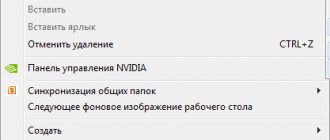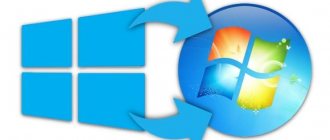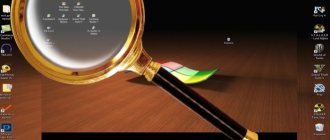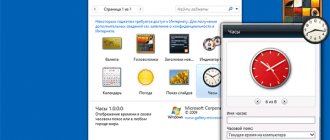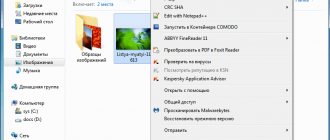The concept of personalization first appeared in Windows Vista. This is a set of several mechanisms, united under one “roof”, with the help of which you can influence the appearance of the operating system interface. This mechanism was transferred to the new operating system practically unchanged, with some improvements in the interface and the use of additional effects. As before, the Personalization mechanism is located on the Control Panel (Fig. 7.1).
Rice. 7.1. Launch the Personalization component
Using the Personalization mechanism, you have access to configure the following system interface parameters:
- Desktop themes
- desktop background
- window colors
- sounds
- screensavers
- desktop icons
- mouse pointers
- account picture
Let's briefly consider these parameters.
DESKTOP THEME
The visual design of the Desktop is the first thing that catches your eye after starting the operating system. As they say, “you are greeted by your clothes,” and it is this fact that affects whether you will be able to use the operating system with pleasure in the future or simply get used to it. It has long been proven that the visual perception of an object clearly affects its practical use. So, let's see what the new Windows 7 operating system offers us in terms of visual design.
After launching the Personalization mechanism, you will see a window with the theme settings tab activated (Fig. 7.2). The Desktop Theme changes not only the Desktop background, but also sounds, window color and other parameters. However, once you select a Desktop theme, you can further change each of the components of the selected theme, including the background and sounds. How this is done is written below.
Rice. 7.2. Setting the Desktop Theme
The Windows 7 operating system in its standard configuration offers a choice of two theme options: Aero and standard basic themes. Users whose computer power meets the recommended requirements for installing the Windows 7 operating system are a little more fortunate, since instead of the standard theme, they can choose one of the Aero themes, which have much more visual effects. Other users can also install Aero themes, but as a result they will only get the appropriate Desktop background and sound scheme, but will not be able to enjoy most of the effects: window transparency, taskbar additions, visual effects when switching between windows, etc.
Installing the theme is quite quick - you just need to select the theme you like from the list. As a result, you immediately see the result and can easily install the theme that best suits your mood and idea of how your desktop should look.
Also note that at the top right of the list is a link to More Internet Topics. Clicking on it will take you to the Microsoft website, to the personalization section, which contains a wide variety of themes and desktop backgrounds that are not included in the standard set. By clicking the Download button and selecting the Open option in the window that appears, you simplify the process of installing the theme into the operating system as much as possible. All you have to do is wait for the download process to complete and allow the installation of the new theme. Any theme that is installed in a similar way, for example by downloading from the Internet, subsequently ends up in the My Themes section, located at the very top of the list of themes.
Classic Color Panel for Windows 10
Classic Color Panel is a small utility for changing the colors of almost all elements, which can be downloaded from the official website: www.wintools.info/index.php/classic-color-panel. The utility works by making changes to the registry, which can also be done manually.
- Download the program from the official website and run it (no need to install).
- The second mandatory step is to create a copy of the current settings (you will need to return the default settings at any time).
- Next, select Window and set any color.
- To save the settings, select the Apply menu item, after clicking on which you will be logged out of the system.
The Classic Color Panel program has shown itself to be excellent in all builds of Windows 10. What will happen next is not known, but most likely it will be possible to continue changing the color of windows and other elements in this same way.
conclusions
We showed how you can change the color of windows in Windows 10 using built-in tools and using the Classic Color Panel utility. Do not forget that the method of changing the color of the window title through the new parameters works when you have an activated Windows 10 build no lower than 10586 installed. We have shown only three of the most convenient methods, in my opinion. I hope this article was interesting for you, write in the comments what other convenient methods you know.
DESKTOP BACKGROUND
The Desktop background, as part of the theme, can also be changed at any time. For example, do you like the sounds of the installed theme, but don't like the background used? No problem: changing your desktop background is as easy as changing the theme itself, so don't worry, just choose a different one. To change the background, click on the Desktop background link (see Figure 7.2). In the window that opens (Fig. 7.3) you will see a list of images that change depending on which location source is selected. For example, you can use images from an image library or select the most popular photos. If you don’t have enough of what you have, you can always click the Browse button and specify any folder with images. Just like the theme, the background image changes on the fly so you can see the results right away. If you don’t like it, choose any other image, especially since there are quite enough ways to do this. Now comes the fun part. The operating system allows you to set either one permanent image or set up a slide show of the images you select. Setting a “stable” image is very simple: select a suitable background and click the Save changes button. To set up an image slideshow, you need to do the following.
Rice. 7.3. Changing the desktop background
1. Mark the images that should be included in the slide show. In this case, it is most convenient to save the necessary images in one folder, and then specify it using the Browse button. You can then click the Select All button to select all images at once. You can also tag images using the Ctrl or Shift key. 2. Specify the position of the image by selecting one of the values Fill, Fit, Stretch, Tile, Center from the list of the same name. If the image is larger than the screen resolution, this will not lead to problems, you just need to select the Fill or Stretch option from the list. If the image resolution is lower and it becomes distorted when stretched, you can modify the Desktop background by choosing a color that complements the image. To do this, use the Change background color link at the bottom of the window. 3. Select the frequency of changing images using the Change images every list. There are options from 10 seconds to 1 day. The most optimal and “calm” option is to set the frequency to around 1 hour: it’s both pleasing to the eye and not boring. 4. Specify the method for changing images. By default, the images are rotated in order as shown in the list. If you want to add some variety to your slideshow, you can check the Shuffle box. To apply the changes you have made, click the Save Changes button.
WINDOW COLOR
The ability to customize the window color scheme has been carried over from the Windows XP operating system, without any changes. To use this mechanism, you need to click on the Window color link at the bottom of the window shown in Fig. 7.2.
There are quite a lot of controls to choose from, the color scheme of which you can customize. Some of them apply only to the Aero theme, while most of them relate to the standard Desktop theme, as indicated by the inscription in the window that opens. Here, in addition to the actual color design of windows and its elements, you can also customize the display of inscriptions, specifying the font and size. For example, you can set a different font for the window title, define the spacing between icons, the color of hyperlinks, and much more.
SOUNDS
Sounds, that is, sound design, are directly involved in the perception of the Desktop, so it is only natural that the Windows 7 operating system allows you to customize them at your discretion. To switch to sound management mode, select the Sounds link in the window shown in Fig. 7.2. A similar configuration method existed in Windows Vista, and compared to this operating system in Windows 7, there were no significant changes in this regard. Controlling sounds is very easy. There are more than ten different sound schemes to choose from, which you can set using the Sound scheme list. Once the sound scheme is selected, you can proceed to manage the sounds responsible for various operating system events.
In the central part of the window (Fig. 7.4) there is a list of all system events and sounds associated with these events. If the sound is installed, the speaker icon is displayed next to the corresponding event. Regardless of whether the sound is installed or not, you can change it or link it to an event, for which you use the Sounds list: having marked the desired event, expand the Sounds list and select from it one of 40 sounds at your discretion. If you don’t need any sound for the event at all, select No from this list.
Rice. 7.4. Changing the soundtrack
You can do the same with any system event. This will create a new sound scheme, which you can save using the Save As button, allowing you to select it at any time. If you are not satisfied with the set of system sounds, you can specify your sounds using the Browse button. By default, only WAV files can be selected. But is this a problem if there are a large number of programs with which you can easily convert any audio file to WAV?
SCREEN SCREEN
Because there are times when you are not at your computer, your operating system may display a splash screen when you enter power-saving mode. At the same time, in addition to saving energy, you get a pleasing picture. And in addition, you can make it so that exiting the screen saver mode will be possible only after entering the password. This means that the information on your screen can't be seen by anyone, especially people who don't need to see it in the first place. The mechanism for working with screensavers has remained virtually unchanged since its appearance in earlier versions of the operating system. Why change anything in a useful and, most importantly, properly working mechanism?
To be able to manage screensavers, select the Screensaver link, which is located in the lower right part of the window shown in Fig. 7.2. In the window that appears (Fig. 7.5), you can select any screensaver you like from the Screensaver list. At the same time, a small copy of the screensaver is displayed on a small screen at the top of the window. If you click the View button, you can see its work “live”, in full screen mode.
Rice. 7.5. Setting up your screensaver
Almost all screensavers have settings that can be customized. For example, if you select the Photos screensaver, as shown in Fig. 7.5, then after clicking the Options button you can specify the folder with your images that will participate in the slide show. You can also choose the speed at which these images change. If you want to exit screen saver mode only when you enter your password, select the Start at login screen check box. This opportunity is very often used by office workers, especially if one office is shared between several colleagues.
Selecting a screensaver
If desired, you can install a screensaver. This is not necessary, but still. The screensaver is activated after a certain amount of time the PC has been idle (when no one has used it) and adds a little variety. Setting it up is very simple:
- Click on the "Screen Saver" item.
- Select any option from the drop-down list - for example, soap bubbles.
- Specify the interval (i.e. time) at which it will appear and click Apply.
To preview the screensaver, click the Preview button.
CHANGING YOUR DESKTOP ICONS
As you may have already noticed, by default, immediately after installation, the operating system displays only the Recycle Bin icon on the Desktop. It is not clear what the reason for this decision is, because the Computer and Network icons are used much more often in practice, and yet the developers decided not to display them. This kind of “disgrace” is very easy to fix. First of all, you need to launch the mechanism for working with icons, for which you use the Change desktop icons link on the left side of the window shown in Fig. 7.2.
As a result, a window will open in which you will see a list of standard icons, as well as parameters that show their current state (Fig. 7.6). If you want the Computer and Network icons to be present on the Desktop, simply check the appropriate boxes in this window.
Figure 7.6. Customizing the appearance and display of icons As in previous operating systems, in Windows 7 you can change the icon by clicking the Change Icon button. As a result, a window will open containing a fairly large set of various icons. To return the standard icon image, click on the Normal icon button. If you want the desktop icons to change when you install a new desktop theme, check the Allow themes to change desktop icons checkbox. In this case, the icons may take on a more original appearance.
Most frequently asked questions
Users often have questions and some problems when trying to install a third-party theme on their Windows. The most common ones are collected here. It should be remembered that these tips are not a panacea, but only the most common ways to solve problems:
- Question: Why does the appearance of the icons not change after changing the design style? Answer: Icons are configured separately as they are not part of the theme.
- Question: Why is the theme transparent in the screenshots, but not after installation? Why is the background of window title bars different from the background of frames? Answer: These parameters are configured using the aero glass program.
- Question: Why did the window control buttons not change in appearance after installing the theme? Answer: This is due to incorrect installation of aero glass.
- Question: Why do the interface elements turn white when calling the task manager using the combination CTRL - ALT - DELETE, despite the fact that the theme itself is dark? Answer: To fix this problem, it is recommended to use Remove Default Color.
- Question: How can I design the taskbar and Start menu to match the theme? Answer: It is recommended to use the StartIsBack Plus program.
- Question: How can I change the Explorer interface? Answer: It is recommended to use OldNewExplorer.
Changing the design style is an excellent opportunity to customize your PC to suit the user's individual tastes. However, due to the nature of Windows operating systems, care must be taken when performing such interventions.
CHANGING MOUSE POINTERS
The ability to customize mouse pointers existed in the earliest versions of the Windows operating system, so the developers of Windows 7 decided not to reinvent the wheel and use an already established mechanism. At the same time, they took it in the form in which it is present in Windows Vista. As before, the user has the ability to configure the following parameters. p Mouse buttons. You can adjust the double-click speed, enable or disable sticking, and reconfigure the button layout for left-handers.
p Pointers. There are over 10 different signage designs to choose from. In this case, you can customize the appearance of the pointer for each mode and enable the display of shadows. It is also possible to allow or disable changes to pointers when installing new themes. p Pointer options. You can configure such pointer parameters as the speed of its movement, hiding from the screen when entering from the keyboard, setting the pointer to the default button, displaying the “tail”, etc. Wheel. The mouse wheel can also be customized, for example, you can specify the number of lines by which you want to scroll the contents of the window with one scroll of the wheel. If you have a mouse whose wheel can be tilted left and right, you can also use this feature for scrolling, for example, you can set the entire screen to scroll, which is convenient when reading e-books.
Required programs
for some reason, it ignores the developers of third-party software for personalizing Windows in general and Win 10 in particular, so in order to install third-party styles, it is necessary to make changes to the operation of the system.
For this, there are special programs and patches that allow you to change design styles. Programs are most often non-universal and designed for one or more specific systems. This means that a utility that works with Win 10 will be useless on 7 - and vice versa.
Most programs are good because they expand customization options without changing Windows system files, allowing you to use them without fear for the performance of your PC.
However, there are programs that change standard settings and files, which can cause problems when trying to remove installed themes and return the system to its original appearance. Therefore, before making changes to the system, it is advisable to create a restore point. Otherwise, you may need to reinstall the system.
Examples of similar programs for Win 10:
- UxStyle Windows 10. A patch that allows you to install themes and third-party design styles for Windows 10. It is famous for its combination of simplicity, reliability and efficiency.
- UXTheme Multi - Patcher 14.2. A non-commercial utility created to improve the uxtheme system file. dll, after which the ability to install third-party personalization elements becomes available to the user.
Before downloading any of the programs, you need to find out the exact OS version. This is necessary because Microsoft regularly updates its operating systems, and older versions of programs do not always support the updated OS.
CHANGING YOUR ACCOUNT PICTURE
The account picture is what you see when you enter your login password or exit screensaver mode. Additionally, this graphic also appears at the top of the Start menu. Not everyone likes the icon chosen by the system, such as a bunny or a fish. The icon can be changed, and this is done very simply. First of all, you need to click on the link Change account picture, which is located on the left side of the window shown in Fig. 7.2.
As a result, a window will open in which you will see a set of images, as well as the image that your account is currently using (Fig. 7.7). Any image present in the window can become a picture for your account; you just need to select it and click the Change picture button. You can also select your own picture. To do this, you just need to follow the Search for other pictures link and indicate its location on the disk. The main graphic file formats are supported.
Rice. 7.7. Changing the account picture In the same way, you can change the pictures for other accounts that are registered in the operating system. If you have administrator rights, of course...
Using and setting up gadgets
As mentioned earlier, unlike Windows Vista, in which gadgets could only be displayed in a special sidebar, in Windows 7 they can be placed anywhere on the Desktop (Fig. 9.1). In addition, it became possible to change the size of the gadget window.
Rice. 9.1. Example of gadgets on the desktop
The number of gadgets is increasing every day, and their quality is also increasing. Windows 7 has 9 standard gadgets. In addition, you can download new ones from the Microsoft website or from any other. Gadgets vary in purpose. The most interesting ones are those that work as web services. Examples of such gadgets are weather, currency, news, etc. informers, that is, those that display data from the Internet. There are also general-purpose gadgets, such as clocks, various mini-games, slide shows, etc. To manage gadgets, use the Control Panel item called Desktop Gadgets (Fig. 9.2). After launching it, a window will appear (Fig. 9.3).
Rice. 9.2. Launching the Desktop Gadgets mechanism
Rice. 9.3. List of available gadgets
This window displays a list of gadgets that are currently installed on the system. Over time, as the number of gadgets increases, all of them do not fit in this window, so the list can be scrolled using the navigation bar in the upper left corner of the window. Each element of this list is provided with a short description, which appears when the desired gadget is selected. By default, this window is displayed in compact mode, so you will need to enlarge it to see the description. To do this, select the Show details link in the lower left corner of the window. As mentioned above, new gadgets can be downloaded from the Internet, in particular from the Microsoft website. To do this, use the Find gadgets on the Internet link in the lower right corner of the window.
To add a gadget to your Desktop, simply drag it from the list to your Desktop. Or right-click on the gadget and select Add from the context menu that appears. For example, let's look at the use and configuration of a standard weather gadget (Fig. 9.4). Rice. 9.5. Example of a weather gadget The window size of almost any gadget can be changed. In this case, increasing the window size can add functionality. For example, if you drag a weather gadget onto the desktop, by default it will be displayed in a smaller version, which implies displaying only the weather forecast in the selected city at the current moment. If you enlarge it, it will show the weather forecast for four days and in more detail (Fig. 9.5). Rice. 9.5. Enlarged gadget window The window is enlarged as follows. If you move the pointer to the gadget, an additional panel with buttons appears, among which there is a Larger button. When pressed, the window size increases.
On the same panel there is also a Settings button, which opens a window with gadget settings. In our case, if you click this button, the window shown in Fig. 9.6. There are only two parameters that affect the operation of the gadget - changing the type of temperature display and selecting the city in which the weather should be shown.
Rice. 9.6. Setting up the gadget To change the city to any other, for example, St. Petersburg, type part or all of the city name and click the search button. As a result, a list of matches will appear from which you must select the desired position. After that, click OK and enjoy the result.
Set the interval before turning on the screen saver in Registry Editor
1. In the search bar or in the “Run” menu (run using the Win + R keys), enter regedit and press the Enter key.
2. If you want to set the interval for the user under which they logged in, go to the path HKEY_CURRENT_USER Software Policies Microsoft Windows Control Panel Desktop . If you want to set the interval for all computer users, go to the path HKEY_LOCAL_MACHINE SOFTWARE Policies Microsoft Windows Control Panel Desktop. If there is no Control Panel section in the Windows section, right-click on the Windows section, select “New” => “Partition” => name the new section Control Panel
Right-click on the Control Panel section, select “New” => “Section” => name the new section Desktop
3. Right- click on the Desktop ScreenSaveTimeOut
4. Open the ScreenSaveTimeOut => in the “Value” field, enter the interval in seconds before turning on the screen saver and click “OK”. Close Registry Editor.
That's all for today, if you know other ways - write in the comments! Good luck to you
